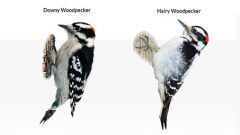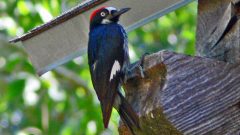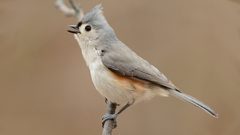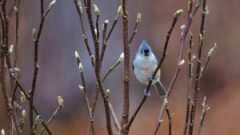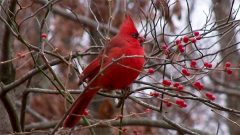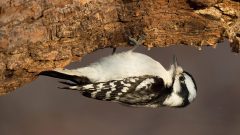Downy Woodpecker Similar Species Comparison
Main SpeciesDowny Woodpecker
Male (Eastern)
Small with a short bill. White below, upperparts mostly black with a white back and bold white spots in the wings. Head striped black and white, with a red nape. Note spotting on white outer tail feathers.
© Evan Lipton / Macaulay LibraryRhode Island, February 02, 2017Male (Pacific)
Birds along the Pacific coast are dingy brownish-gray below.
© Grace Oliver / Macaulay LibraryWashington, February 05, 2017Female (Eastern)
Picks and probes bark for insects and larvae.
© Timothy Barksdale / Macaulay LibraryArkansas, July 20, 2004Female (Eastern)
Small and short-billed. Females lack the red nape found on males.
© Scott Martin / Macaulay LibraryMassachusetts, February 03, 2017Female (Pacific)
Birds along the Pacific coast are dingy brownish-gray below. Females lack the red spot on the nape.
© John F. Gatchet / Macaulay LibraryWashington, March 08, 2017Female (Eastern)
Males and females drum steadily on trees to defend their territory, attract mates, or maintain contact with their mate.
© Timothy Barksdale / Macaulay LibraryArkansas, March 14, 2005Juvenile
Juveniles have red feathering on the cap.
© Jeff Langford / Macaulay LibraryUtah, July 18, 2016Female (Pacific)
White outer tail feathers with some black spots.
© Ryan Merrill / Macaulay LibraryWashington, November 09, 2016Male (Eastern)
Common visitor to backyard bird feeders, especially suet feeders.
© Matthew D. Medler / Macaulay LibraryNew York, November 29, 2014Male (Eastern)
Will sometimes perch on branches like a songbird, and occurs in a wide variety of wooded habitats.
© Matthew Plante / Macaulay LibraryOhio, November 26, 2020Adult male and juvenile
Males and females feed their young up to 3 weeks after they leave the nest.
© DAVID BROWN / Macaulay LibraryNew York, June 01, 2004Habitat
Found in open woodlands, especially deciduous woods, and in suburban yards, parks, and orchards.
© Mike Thelen / Macaulay LibraryIllinois, July 05, 2017Similar SpeciesHairy Woodpecker
Male (eastern)
Hairy Woodpeckers are larger than Downy Woodpeckers with a longer bill. The outer tail feathers on Hairy Woodpeckers are unmarked, but they are spotted on Downy Woodpeckers.
© Jean-Sébastien Guénette / Macaulay LibraryQuebec, February 26, 2016Similar SpeciesHairy Woodpecker
Female (Rocky Mts.)
Hairy Woodpeckers are larger than Downy Woodpeckers and have a larger bill that is almost as long as the entire head.
© Jerry Elling / Macaulay LibraryArizona, September 30, 2016Similar SpeciesRed-cockaded Woodpecker
Adult
Red-cockaded Woodpeckers have a black-and-white barred back and a large white cheek patch unlike Downy Woodpeckers that have a white patch down the back and two stripes on the face.
© Luke Seitz / Macaulay LibraryFlorida, January 08, 2014Similar SpeciesLadder-backed Woodpecker
Male
Ladder-backed Woodpeckers have a barred black-and-white back unlike Downy Woodpeckers.
© Edward Plumer / Macaulay LibraryTexas, February 20, 2016Similar SpeciesNuttall's Woodpecker
Male
Nuttall's Woodpeckers have a barred black-and-white back, lacking the Downy Woodpecker's white back patch.
© David M. Bell / Macaulay LibraryCalifornia, May 03, 2017Similar SpeciesYellow-bellied Sapsucker
Male
Yellow-bellied Sapsuckers have a white wing patch and a red crown that Downy Woodpeckers don't have.
© Margaret Dunson / Macaulay LibraryMichigan, May 25, 2017Compare with Similar Species
Click on an image to compare
Species in This Family
Woodpeckers(Order: Piciformes, Family: Picidae)
More to Read
Don't miss a thing! Join our email list
The Cornell Lab will send you updates about birds,
birding, and opportunities to help bird conservation.

























